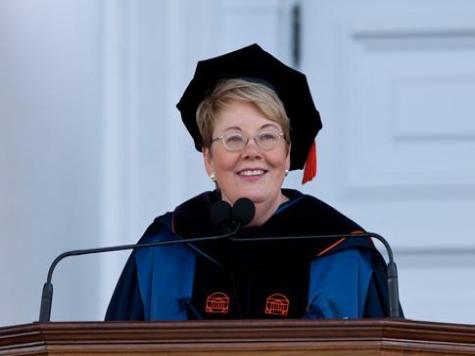In 1990, Rutgers Professor Philip Shuchman charged Elizabeth Warren, along with Teresa A. Sullivan (above), the President of University of Virginia who resigned unexpectedly yesterday, and Jay Westbrook, her two co-authors of the 1989 book, As We Forgive Our Debtors: Bankruptcy and Consumer Credit in America, with “scientific misconduct.” Within a few months, Warren’s friends and former colleagues at the University of Texas quickly completed an error-filled investigation.
This secret report was accepted by University of Texas President William Cunningham. For two decades, Warren and her co-authors have claimed in academic circles that this report–never before made public–exonerated them.
But the central charge made by Professor Shuchman was neither investigated nor refuted in this secret report. Shuchman cited four specific criticisms of the 1989 book. It is the fourth and last complaint upon which charges of scientific misconduct hang.
Professor Shuchman concluded his book review with this powerful allegation:
This book contains so much exaggeration, so many questionable ploys, and so many incorrect statements that it would be well to check the accuracy of their raw data, as old as it is. But the authors arranged matters so that they could not provide access to the computer printouts by case, with the corresponding bankruptcy court file numbers, this preventing any independent check of the raw data in the files from which they took their information.
In the footnote to this paragraph, Shuchman notes:
A common instance of misconduct in science occurs when “there [is] no way to verify whether or not [the] research was accurate.’ Woolf, Deception in Scientific Research, 29 Jurimetrics J. 67, 83 table 5 n.4 (1988).
The 1991 University of Texas secret report that “exonerated” Elizabeth Warren never asked this simple question:
Did the authors arrange matters so that they could not provide access to the computer printouts by case, with corresponding bankruptcy court file numbers, thus preventing any independent check of the raw data in the files from which they took their information?
Sullivan, Warren, and Westbrook deployed a research methodology that was apparently contrary to the methodology they stated they would use in their National Science Foundation (NSF) grant proposal, which financed their research. After they received their funding, they chose to apply “human subject safeguards” by removing identifying information (case number, petitioner name, and a subsequent “identifier” they added) from the raw data files used in the study–over 1,500 bankruptcy records, each one containing over 200 fields of information (such as assets, liabilities, homeownership, marital status, etc.) That change in methodology made their research data, in effect, unverifiable.
Documents obtained from the NSF suggest that the “human subject safeguard standards” that Warren, Sullivan, and Westbrook imposed on their data were never approved of by that agency, were not consistent with the law, and were never known to the NSF until after the book had been published and Shuchman’s complaint filed.
Twenty-two years later, Professor Shuchman’s charges of “scientific misconduct” against Elizabeth Warren and her co-authors remain publicly unanswered and unresolved. These unresolved charges associated with her first major book raise continue to raise questions that hang over Elizabeth Warren’s entire body of academic work.
The next three articles in this series will address the conduct of three institutions enmeshed in this scandal: The University of Texas, the National Science Foundation, and Harvard University.

COMMENTS
Please let us know if you're having issues with commenting.